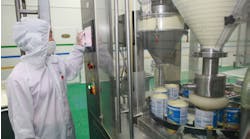THIS MONTH’S PUZZLER
Our polyphenylene ether (PPE) process generates a lot of dust and PPE resin is a severe fire hazard. I’m tasked with figuring out a way to collect and reprocess this dust. I’m considering agglomeration. Do you think this is a good option? If so, what do I need to do? If not, what would you suggest?
START FROM SCRATCH
There are three ways to approach this problem: 1) eliminate the dust upstream; 2) coat polymer particles with additives to ameliorate sparking and reduce dust formation; and 3) use agglomeration.
Available additives such as silicone resin modifiers may reduce the dust problem significantly. However, they may introduce product quality problems such as poor aging properties, lower mechanical strength and discoloration.
One manufacturer’s PPE material safety data sheet reads: “Dust may form explosive mixtures with air. Avoid dust formation and control ignition sources. All plastic dust particles suspended in air are combustible and may be explosive. Keep away from heat, sparks, flame and other ignition sources. Prevent dust accumulations and dust clouds.”
Under these circumstances, agglomeration is a necessity. Obviously, it must be done in an inert atmosphere. The selection of binding agent also will require caution. Table 12.12 on p. 354 of the first edition of Stanley Walas’ “Chemical Process Equipment — Selection and Design” recommends an alcohol as binder for a disc pelletizer (agglomerator). I would substitute any solvent that will soften the PPE dust; a plasticizer or even the monomer might suffice. You want a binder that either can be driven off or can become an innocuous part of your product. Tests are needed to first verify solubility and then to scale-up the process on a bench. If the binder is too soluble or can be driven off during transportation of the pellets, you’re back to where you started.
Now, for the hard part: inerting. You either can keep the process in an enclosure and flood it with an inert gas like nitrogen or cool down the process and pull a vacuum to reduce the available fuel.
Some safety tests are in order: 1) measurement of the lower explosive limit (LEL) and upper explosive limit of the binder agent under operating conditions; 2) measurement of the exotherm from aerated powder (when the dust begins to combust, thereby producing heat); and 3) a bulk powder test to determine exotherm temperature when the powder is collected in bins, hoppers and in the agglomerator. “Prevention of Fires and Explosions in Dryers” by John Abbott describes these tests. Various equipment vendors may offer more germane tests. I also would look at the U.S. Occupational Safety and Health Administration web page.
As far as the basic design, I would start with a spray drum to apply the binder, followed by the disc pelletizer and then a vibrating screen (to eliminate fines that didn’t get agglomerated) that feeds a vacuum conveyor. A baghouse will be required in front of the blower to remove trace dust. Flow between the equipment could be by gravity slide with gentle vibration to reduce dust buildup. A measurement of the static electric potential would be necessary to safely use the vibrating screen and flow activators for the slides.
If this process were done on a small scale, it could be enclosed in a nitrogen tent. This would require makeup nitrogen — and strict enforcement of precautions against asphyxiation. Safety controls would include a few LEL detectors strategically placed to catch leaks.
Dirk Willard, project engineer
Superior Engineering, Hammond, Ind.
SEPTEMBER’S PUZZLER
We bought an old refinery with a history of safety and reliability problems. One area we’re particularly concerned about is the current light slop oil system (Figure 1). The knock-out drum has a level transmitter that only covers part of the drum diameter, the containment area around the drum drains to the storm water sewer, and the slop-oil and sour-water level control valves are fail-closed. In addition, the minimum flow orifices of the knock-out-drum pump only are sized to prevent over-heating of the bowls. Then, there’s the sump that the sour water empties into: it uses a simple bubbler for level control; there’s no conservation vent or emergency vent, nor vapor space control in the sump pump room and the sump overflows to the ground. How should we establish our budget to modernize this system? Will we have trouble getting new permits? How can we improve the reliability of the equipment?
Figure 1. New owners want to modernize system to address several deficiencies.
Send us your comments, suggestions or solutions for this question by August 12, 2013. We'll include as many of them as possible in the September 2013 issue and all on ChemicalProcessing.com. Send visuals — a sketch is fine. E-mail us at [email protected] or mail to Process Puzzler, Chemical Processing, 555 W. Pierce Road, Suite 301, Itasca, IL 60143. Fax: (630) 467-1120. Please include your name, title, location and company affiliation in the response.And, of course, if you have a process problem you'd like to pose to our readers, send it along and we'll be pleased to consider it for publication.

